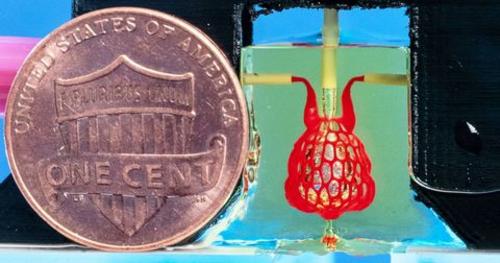Have you ever woken up and thought, “Wow, I really wish I had a car right now?” Well with 3D printing, your dream can become a reality. Although modern 3D printers can print a toy car, they may not be able to print an entire car (yet). However, they are still revolutionary due to their simple but effective functionality, local availability, as well as their research and industrial applications.

3D printers create objects using a method called fused depositional modeling (FDM). Normally on a printed page, the ink sits slightly atop the paper and so it sticks up just a very little bit. 3D printers build on this foundation. FDM entails repeatedly printing layers on other layers, waiting for them to cool and then continuing this process. The object to be created is first drafted using a 3D computer aided drawing (CAD) and then the printer creates the object using FDM. Objects can be made from many different materials, which are specialized for many different situations. For instance, acrylonitrile butadiene styrene (ABS) and poly lactic acid (PLA) filaments are low cost options that are very durable whereas polyvinyl alcohol (PVA) is designed to dissolve in water.
If you want to try some 3D printing or even just see it in action, you can visit the University of Waterloo’s Rapid Prototyping Centre at Engineering 5. They have two 3D printers named Wall-E and Eve. The Rapid Prototyping Centre is not limited to students in Engineering; anyone can make use of this service. They have a plethora of customizations for your print including: materials, resolution and density. Prices for students are $9.25/cubic inch and $12.50/cubic inch for standard and enhanced resolutions respectively. Making your own 3D print is a simple process, First, design and draft your model in any Computer Aided Drawing software (CAD) then obtain a quote by filling out a form and finally, make an online payment and then wait to collect your part. There have been some quite remarkable prints at the Rapid Prototyping Centre.
Furthermore, the Anthropology department in the Faculty of Arts incorporates 3D printing in their regular work. Robert Park, Professor and Acting Department Chair of Anthropology, explained how the department uses this technology. Firstly, he explains that they typically print 3D models of fossils to use as teaching aids during lectures and tutorials. The models allow for full visualization and minimal confusion from students and are comparatively inexpensive to manufacture. Many fossil designs are available on the website MorphoSource, a digital repository hosted by Duke University.
These models are not only beneficial in a teaching sense but also from a research perspective. Researchers often recover the discarded remains of artifacts, which can be useful but certain parts may be missing. Professor Park says researchers are able to create full 3D printed models of recovered artifacts, complete with the missing pieces. For instance, ancient Inuit people would make sewing needles by carving them from caribou bones. Researchers would come across the discarded bones and needles, reconstruct them and then print models for further analysis.

Additionally, 3D printing has many industrial and research applications in many fields such as aerospace, software and even medicine. 3D bio-printing is a procedure where biomedical parts are fabricated so that they imitate properties of living tissue. For instance, a team of students at Rice’s Brown School of Engineering were able to print an organ that replicates the functionality of a human lung. They created a new open-source technology called “stereo-lithography apparatus for tissue engineering” (SLATE). In this process, layers are printed singularly from a liquid pre-hydrogel solution that solidifies on exposure to UV. Researches are also using 3D printed organs to study how cancer affects them and possible ways of mitigating this.
References
1. Grossman, D. (2019, 05 03). Scientists Successfully 3D Print an Organ That Mimics Lungs. Retrieved from Popular Mechanics: https://www.popularmechanics.com/science/health/a27355578/3d-print-lungs/
2. Simplify 3D. (2019, 09 23). Ultimate 3D Printing Materials Guide. Retrieved from Simply 3D: https://www.simplify3d.com/support/materials-guide/
3. University of Waterloo. (2019, 09 23). 3D Print Centre. Retrieved from Rapid Prototyping Centre: https://uwaterloo.ca/3d-print-centre/












